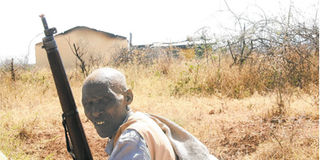Politics and foreign militia blamed for killings in Marsabit

FILE | NATION
A Kenya Police Reservist outside Funanyata Primary School that was torched following clashes between the Gabra and the Borana. Schools are yet to reopen in Marsabit nearly a fortnight after raids in which at least 10 people died.
What you need to know:
- Over 100 people killed in attacks that have also displaced families and affected trade
- Alliance formed to win elections in March led to rise in tension
Politics of exclusion and clan rivalry are some of the key issues fuelling violence in northern Kenya.
Results of the just concluded elections that resulted in members of some clans missing out to be elected in different position has aggravated the ongoing bloodletting in Marsabit, Wajir and Mandera counties.
In the recent past, members of the Gabra , Borana, Garre, Ajuran, Murule, Degodia and Marihan in Moyale, Wajir and Mandera counties have been involved in skirmishes which have resulted in the death of more than 100 people and displacement of thousands.
A website which calls for the secession of parts of North Eastern has also been blamed for rising tension in the region as leaders asked police to speed up investigations into the recent spate of killings.
The website has a map that shows a new region called Gaareland republic which stretches from Isiolo, Moyale, Wajir and Mandera to parts of Ethiopia.
Just like the famous Mombasa Republican Congress, the group has its president and they call him Sultan, and a map showing the Gaare Republic.
In Marsabit, inquiries by Nation shows that members of the Gabra community successfully managed to enter into a political alliance with the Rendille and Burji and formed a new political outfit called Regabu in a bid to capture crucial seats in the devolved government.
The word is an acronym for Rendile, Gabra and Burji.
The move was ostensibly to isolate members of the Borana community who, as the majority ethnic group, have dominated politics of the county since independence.
This is what is being blamed for the skirmishes in Moyale that have left at least 10 people dead and thousands of others displaced.
Boranas and Gabras have since 2004 been fighting over control of resources in Marsabit
“There is much hatred and suspicions between the two communities. So when Gabras teamed with other small communities to form Regabu, Boranas felt threatened and this is what has caused the present conflict,” Marsabit County Commissioner Isaiah Nakoru said in an interview.
He said Boranas are accusing Gabra leaders of importing people from Ethiopia in preparation for the 2017 elections.
But he quickly denies the claims noting that the government has the machinery to establish who is entering into the country from Ethiopia.
Borans leaders on the other hand accuse the government of favouring their rivals.
“Gabras were few in Moyale but they have been migrating from Ethiopia for the last 15 years and they have now managed to establish their territories,” a former Moyale MP Guyo Halake claims.
A Gabra elder, Huka Kijiba refutes the claims saying their Borana counterparts are seeking sympathy after losing in the elections. Mr Nakoru said the current skirmishes began when an elderly man from the Gabra community was shot dead by a group of militias believed to have been from the Borana community on July 15.
Borans were told to pay for the death and injuries of the two people while Gabras were to vacate their newly settled area. However the former refused to compensate them and the later declined to move.
After a few days, a lorry carrying goods from Nairobi to Moyale was robbed at Kate area, which is dominated by the Boranas. This sparked a conflict turned into a full scale war. Moyale was turned into a war zone where sounds of gun shots were the order of the day.
The fighting has since stopped after the intervention of the Kenya Defence Forces. So far, the County Commissioner said no big fish has so far been arrested over the skirmishes.





